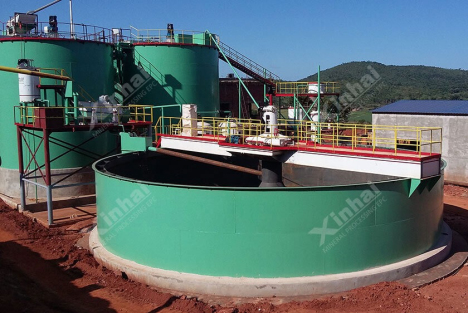The carbon in slurry method was born in the United States in 1880 as a replacement of zinc powder process. Zinc powder replacement required solid-liquid separation. With the emergence of oxidized ores and mixed ores, solid-liquid separation became a problem, so the carbon in slurry method was developed.

Compared with zinc powder replacement, the advantages of carbon in slurry gold extraction are:
1. Wide range of applications for sulfide ore, oxide ore and mixed ore;
2. Fewer operators and lower personnel costs;
3. Less application equipment and shorter process.

1. The number of leaching tanks is selected according to the size of the processing capacity, and the leaching tank is arranged in a stepped arrangement. The pulp enters from the No. 1 tank, relying on the self-flow of the height difference, and the carbon flows in the reverse direction, moving from the back to the front. With the Lower grade of ore slurry, the carbon adsorbs more amount of gold.
Note: No. 1 tank is a leaching tank, and No. 2 tank and other tanks are absorbing tanks. This arrangement is because the No. 1 tank may be mixed with impurities, and there are many large particles of minerals. During the agitation process, the carbon wear is relatively large, so No. 1 tank should not put too much carbon, and carry out impurity discharge regularly.
A safety screen should be added behind the leaching tank to prevent the loss of fine gold. And the filter press is used for solid-liquid separation to process tailings.
2. When the carbon adsorption reaches a certain level, it will enter the desorption electrolysis system for desorption. Add water and sodium hydroxide at about 150°C during desorption and electrolysis to separate gold concentrates from carbon loaded with gold. After this process, the carbon can continue to be used. And the gold mud comes out.

Ordinary mixing tank, single-impeller/double-impeller high-efficiency mixing tank can be used as agitation tanks. The rotation speed is required to be 35-45 rpm to ensure that the pulp and carbon are mixed evenly and the pulp does not settle. Too fast rotation speed will cause carbon wear, and too slow rotation speed will cause uneven agitation or slurry precipitation. Ideally, the carbon is suspended and attached to various places in the leaching tank. Xinhai agitation tank reducer is involute type, which can improve the mixing efficiency and avoid the occurrence of oil leakage.

The charcoal screen is divided into cylindrical screen, bridge screen and peripheral screen, and the most commonly used is cylindrical screen.
The function of the carbon separator is to let the activated carbon enter the sieve and not flow into the leaching tank behind with the pulp.
The carbon separator should be slender as far as possible (the diameter does not need to be too large, and the length should be longer).

Function: to raise carbon from bottom to top
Principle: Using wind pressure, the large pressure below and the small below pressure creats a negative pressure environment. The pulp and activated carbon enter together from the bottom and go out from the top, and the lifting capacity can be as high as 2 meters above the pulp surface.
Linear screen or fixed screen can be selected. In Xinhai's process, linear screen is mostly used. Separation screen can be used for gold-loaded carbon separation and as chip removal and safety screen.

Function: under the condition that the grinding concentration is low, and the leaching requires a high concentration of the pulp, thickeners is necessary before cyanidation process.
The equipment can be selected from ordinary thickeners, high-efficiency thickeners and semi-efficient thickeners. If a flocculant is added to the dense pulp, the concentration can be accelerated, which seems to be very efficient, and a smaller type of equipment can be selected. However, we have to consider the cost in the later stage. The cost of the flocculant itself is not low, costing 30 to 40 RMB per pound. In addition, the flocculant may also adhere to the activated carbon, blocking the pores of the activated carbon and affecting the subsequent adsorption effect.
Therefore, in the selection of thickeners, it is better to choose a larger model than a small model of equipment with flocculant.
1. The choice of agent can be sodium cyanide or calcium oxide
2. The leached pulp requires a concentration of 100~150ppm
3. It’s necessary to ensure the amount of agents is just sufficient and there is a little excess. For places with high environmental protection requirements, purification treatment is required. Proper amount of chemicals can avoid waste and reduce purification costs.
Sometimes lime is added. In arid areas, dry lime can be added during grinding. In areas with high humidity, lime needs to be added to the slurry. The function of adding lime is to ensure the alkalinity of the pulp and ensure that the PH value of the pulp is above 9.5, so as to ensure the stability of sodium cyanide. If the pH value is lower than 9.5, it may cause the volatilization of sodium cyanide.
Before the pulp enters the cyanidation process, chip removal is needed. The pulp entering the cyanidation should be as clean as possible, otherwise it will cause blockage.
Gold ore CIL process, namely, carbon in leaching gold extraction, is a process of adding activated carbon to the pulp to achieve gold leaching and adsorbing at the same time. Two operations complete in one step, reducing management costs while reducing losses.